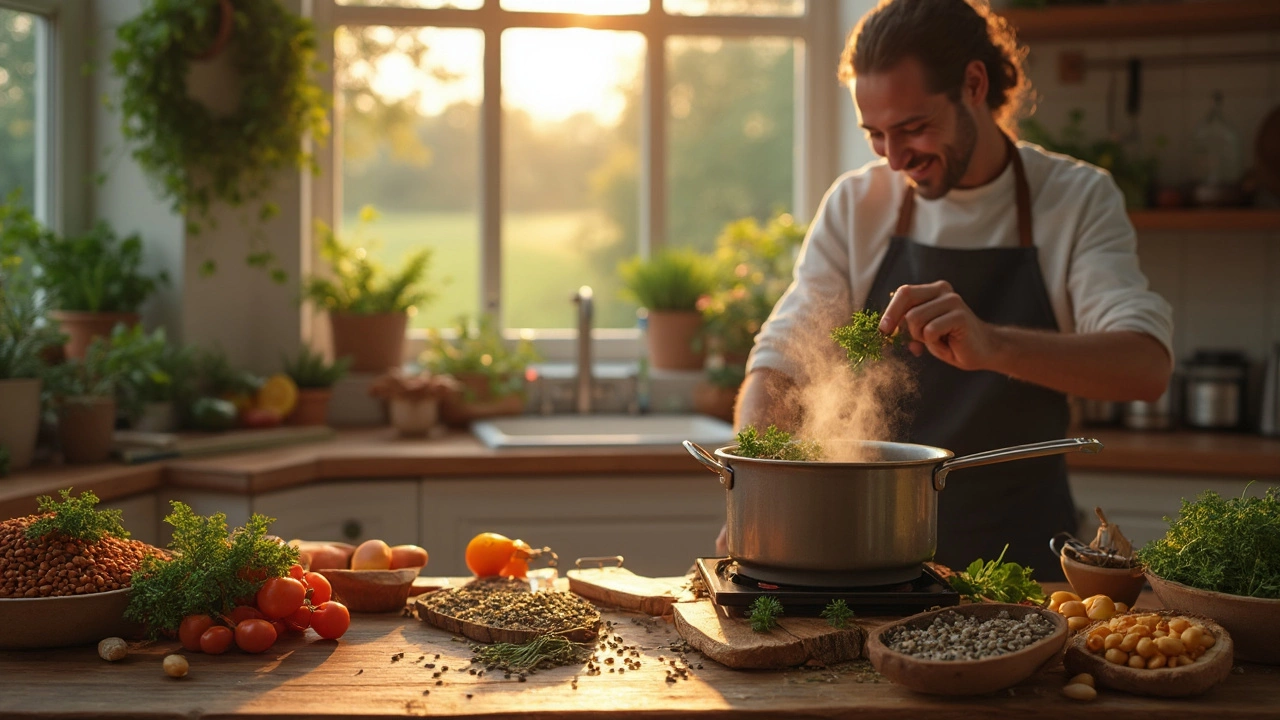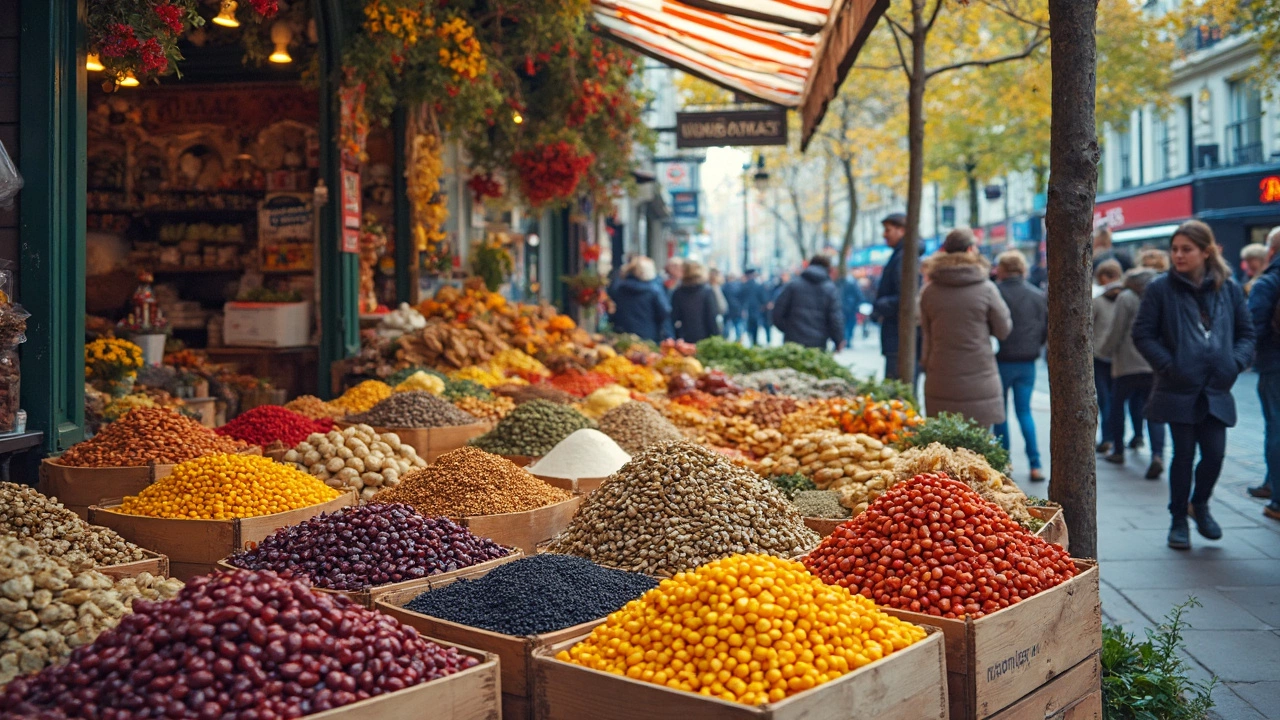Sure, veggies have the spotlight, but when it comes to protein, there's a whole culinary world to explore. Whether you're a seasoned herbivore or just flirting with the idea, getting enough protein without meat might seem tricky at first. But don't worry, you're in for a surprise.
The truth is, the plant kingdom is packed with protein-rich foods. Want beans? Add them to your diet for a powerful protein punch. Chickpeas, lentils, black beans—each brings its own vibe to the table. They're hearty, filling, and easy to cook.
And let's not forget nuts and seeds, nature's snack-sized powerhouses. Almonds, walnuts, chia seeds, and flaxseeds are not just for adding crunch; they're also loaded with protein and healthy fats. Mix them into salads, sprinkle on yogurt, or munch on them straight from the bag.
- Legumes: The Veggie Powerhouses
- Nutty Nutrition: Seeds and Nuts
- Grain Gains: Whole Grains for Protein
- Quick and Easy Recipe Ideas
Legumes: The Veggie Powerhouses
When it comes to vegetarian protein sources, legumes definitely steal the show. They're loaded with protein and packed with fiber, making them a staple in vegetarian diets everywhere. Think of them as nature's little protein packages, bursting with nutrients.
Take a look at chickpeas for instance. With about 15 grams of protein per cup, they're like the Swiss army knife of the legume world. Whether you're making hummus or tossing them into a salad, they fit just about anywhere in your meal plan. Lentils aren't far behind, offering around 18 grams of protein per cup, and they cook up faster than beans, which is great when you're short on time.
But don't just stick to the classics. Black beans, with 15 grams of protein per cup, are incredibly versatile. They're a staple in many cuisines across the world, from Mexican to Caribbean dishes, and always bring a hearty texture to the table.
If you're curious about getting the most protein bang for your buck, check out this quick comparison:
| Legume | Protein (per cup cooked) |
|---|---|
| Chickpeas | 15g |
| Lentils | 18g |
| Black Beans | 15g |
| Navy Beans | 15g |
Cooking these bad boys is pretty simple too. Most dried beans just need a soak and a simmer, or better yet, pop them in a pressure cooker for a quick fix. If you're on a time crunch, canned beans are a convenient alternative, just watch out for added sodium.
Experiment with different recipes and see what you like. Whether it's a hearty lentil soup or a spicy bean chili, using legumes is an easy way to make sure you're getting enough plant-based protein. So next time you plan your meals, be sure to give these veggie powerhouses a spot on your plate!
Nutty Nutrition: Seeds and Nuts
If you're looking for a protein fix, seeds and nuts are your best mates. Besides being snack-sized and portable, they're packed with essential nutrients. It's like having a superfood in your pocket. These little guys aren't just crunchy and delicious; they’re also key players in the vegetarian protein sources game.
Let's look at some nutrition stars. Almonds, for example, aren't just good for your heart. Did you know that just an ounce of almonds packs about 6 grams of protein? That's more than an egg! Walnuts and cashews are also great options, each offering a tasty way to get your fill of plant-based protein.
Now, consider seeds. Chia and flaxseeds are more than just trendy; they're tiny but mighty. Chia seeds contain about 5 grams of protein per ounce, plus a healthy dose of omega-3 fatty acids. Flaxseeds also bring a hefty dose of protein to the table, not to mention fiber and antioxidants.
- Add a spoonful of chia seeds to your morning smoothies or yogurt for an extra protein kick.
- Mix up your salads with a handful of sunflower seeds or pumpkin seeds—perfect for crunch and protein.
- Want a quick snack? Grab a handful of roasted almonds or whip up a homemade trail mix. You’re all set!
Don't sleep on nut and seed butters either. Spread almond butter on whole-grain toast or blend some peanut butter into your smoothie. Trust me, it's a game-changer.
Whether you're tossing them into a dish or munching straight out of the bag, seeds and nuts fit seamlessly into any diet. It's not just about finding new foods—it's about maximizing what you have. So, next time you're thinking about protein-rich foods, don't forget to reach for these crunchy delights.

Grain Gains: Whole Grains for Protein
When thinking about plant-based protein, whole grains might not be the first thing that comes to mind. But they should be on your radar! These grains are crammed with benefits and are a staple in any vegetarian diet.
Quinoa is a superstar grain when it comes to protein content. Did you know it's one of the few plant foods that pack all nine essential amino acids? This means it's a complete protein, just like meat or dairy. Cooked quinoa blends well with just about anything, from salads to hearty stews.
Then there's the humble oats. They're not just for breakfast but can be a great addition throughout your meals. Oats provide a solid protein punch while keeping your heart healthy. They're brilliant in overnight oats, mixed with your fave fruits and nuts, or added to smoothies for extra texture.
Don't sleep on barley either; it's mostly known for soups, but it’s versatile. Its chewy texture adds a nice bite to salads and stuffings with a decent dose of protein.
- Buckwheat: Despite its name, it's not actually related to wheat and is gluten-free. Buckwheat is great in pancakes or as soba noodles.
- Brown Rice: A staple grain that keeps you full and can be paired with pretty much any veggie or protein you choose.
- Amaranth: A lesser-known grain, amaranth is tiny but packed with nutrients. You can cook it like porridge or add it to baked goods for extra texture.
| Whole Grain | Protein Content (per 100g cooked) |
|---|---|
| Quinoa | 4.1g |
| Oats | 2.4g |
| Barley | 2.3g |
| Buckwheat | 3.4g |
| Amaranth | 3.8g |
So if you're looking to up your protein game while keeping things vegetarian, don't underestimate the power of whole grains. They're simple to prepare and can transform into delicious, filling meals. Plus, they're super versatile, making them a must-have in your kitchen.
Quick and Easy Recipe Ideas
Looking for practical ways to get more plant-based protein into your meals? Let's get cooking with some simple and tasty ideas!
First up is the versatile stir-fry. It’s as easy as tossing a bunch of veggies and your choice of protein-rich tofu or tempeh into a pan. Cook it up with soy sauce and a dash of sesame oil. Ready in under 30 minutes, and it’s an instant hit with both taste and nutrition.
Another winner is a hearty vegetarian chili. Combine kidney beans, black beans, corn, and tomatoes with some bell peppers. Include your favorite chili spices, and let it simmer. This protein-packed dish is perfect for batch cooking, giving you meals for days.
For a light yet filling meal, try a quinoa salad. Just cook quinoa and let it cool. Mix it with chickpeas, cucumber slices, cherry tomatoes, and a bit of feta cheese. Drizzle with lemon juice and olive oil. Not only is it rich in protein, but it's also super refreshing.
Want a breakfast boost? Overnight oats are your friend. Mix rolled oats with almond milk, chia seeds, and a spoonful of peanut butter. Let it sit in the fridge overnight. In the morning, top it off with fresh berries or banana slices for a fiber and protein-rich start to the day.
- Stir-Fry Tofu
- Chickpea Quinoa Salad
- Vegetarian Chili
- Overnight Peanut Butter Chia Oats
For folks who love a bit of structure:
- Choose your protein source (e.g., tofu, tempeh, lentils)
- Pick a grain (e.g., rice, quinoa, pasta)
- Add veggies (e.g., spinach, bell peppers, tomatoes)
- Throw in a sauce or dressing
- Enjoy!
With these vegetarian recipes, meeting your protein needs is not just easy, it’s downright delicious!

